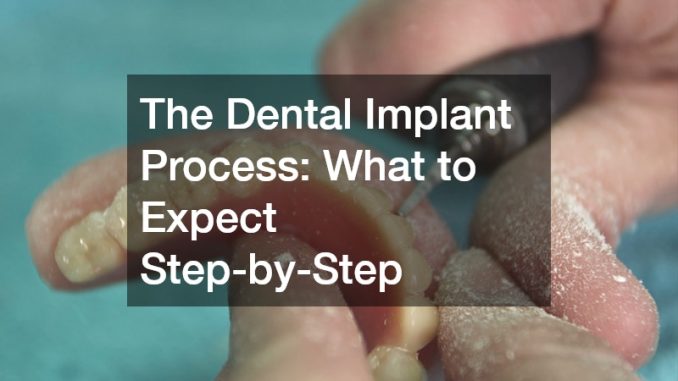

The journey to getting dental implants can be daunting for many, but understanding each step of the process can instill confidence and ease concerns. This article details everything you need to know about the dental implant process, from initial consultation to aftercare, and answers the most common questions about the procedure.
What Are the Stages of the Dental Implant Procedure?
Initial Consultation and Planning
Before even considering the surgical aspects of dental implants, a comprehensive initial consultation is paramount. This phase is not just about gauging the immediate suitability of a candidate but also laying the groundwork for personalized care.
During this session, your dentist or oral surgeon will conduct a thorough examination of your dental and medical history to identify any potential risk factors that might influence the procedure’s outcome. The consultation typically involves a physical examination of your mouth, gums, and teeth to determine any previous dental work that might impact the implant process.
In addition to the straightforward visual exam, advanced imaging techniques often play a vital role in this stage. Technologies such as X-rays and 3D imaging are employed to gather a detailed understanding of the mouth’s internal structures. These images are crucial for assessing bone density and quality, which are critical factors in determining if a patient is a good candidate for implants.
Surgical Placement of the Implant
Once the initial consultation and planning are completed, the next step involves the surgical placement of the implant. This stage is critical because it involves inserting a titanium post into the jawbone, which will eventually serve as the root for the artificial tooth. The procedure is typically performed under local anesthesia, ensuring that the patient experiences minimal discomfort during the surgery. However, for patients with anxiety or particular medical conditions, sedation options are also available to make the process more comfortable.
The surgery itself is meticulously executed, as the oral surgeon makes a small incision in the gum to expose the underlying bone. A special drill is used to create a space in the jawbone, precisely where the implant will be installed. The titanium post is then carefully placed into this space, and the gum is stitched up around the implant to facilitate healing. Implant surgery is typically a straightforward outpatient procedure, and patients can return home later that day after receiving post-operative care instructions.
Osseointegration and Healing
A crucial phase following the surgical placement of the implant is osseointegration. Osseointegration is a biological process where the jawbone begins to naturally grow around the titanium implant, effectively anchoring it as a stable and permanent foundation for the artificial tooth. The success of this phase is vital because it directly impacts the longevity and stability of the dental implant. This process can take several months, with the exact timeline varying from patient to patient based on individual healing capacity and other health factors.
During the healing phase, it’s essential to follow the specific care instructions provided by the dentist to facilitate successful osseointegration. Patients should maintain good oral hygiene to prevent the risk of infection, which could jeopardize the integration process. Adhering to a recommended diet, often consisting of soft foods initially, helps avoid unnecessary pressure or trauma to the implant site. Patients should also refrain from habits such as smoking, as it can impede healing and increase the chances of implant failure.
What Can I Expect During the Recovery Phase?
Immediate Aftercare
The immediate aftercare following dental implant surgery is crucial in ensuring a smooth recovery and successful integration of the implant. Once the surgery is completed, patients are provided with comprehensive aftercare instructions to minimize discomfort and facilitate healing. In the initial days post-surgery, mild swelling and discomfort around the implant site are normal. To alleviate these symptoms, using ice packs intermittently can be quite effective in reducing swelling and managing pain.
Adhering to a prescribed medication regimen is also crucial in managing post-operative pain and preventing any potential infections. Dentists typically prescribe a course of antibiotics and suggest appropriate pain management options, which should be followed diligently. During this stage, maintaining a soft diet is recommended to avoid putting pressure on the implant site. Foods such as yogurt, smoothies, and soft-cooked grains are ideal choices until the implant site begins to heal.
In addition to these measures, practicing proper oral hygiene is essential during the recovery phase. While brushing, patients should be cautious around the surgery site, using a gentle approach to prevent irritation. Rinsing with a recommended mouthwash or saltwater solution can help maintain cleanliness and promote healing. By following these aftercare measures, the recovery phase can proceed smoothly, setting the stage for successful osseointegration and eventual restoration of the dental implant.
Long-Term Maintenance
Long-term maintenance plays a pivotal role in ensuring the longevity and success of dental implants. Once the implant has fully integrated and the restoration process is complete, ongoing care becomes an integral aspect of oral health. Maintaining regular dental check-ups is essential to monitor the implant’s condition and address any potential issues that may arise. Through these visits, dentists can ensure that gums and surrounding tissues remain healthy and that the implant continues to function optimally.
In addition to regular dental visits, proper oral hygiene practices are crucial in preventing complications such as gum disease, which can jeopardize the implant’s stability. Brushing twice daily with a soft-bristle toothbrush and using interdental brushes or floss to clean around the implant helps remove plaque buildup and maintain healthy surrounding tissues. Dentists might recommend specific oral hygiene products tailored to the individual’s needs, ensuring comprehensive care of the implant.
Conclusion
Understanding the dental implant process enriches your knowledge and prepares you for each step, from consultation to recovery. By addressing common questions and concerns, this guide aims to provide a clear pathway to achieving a successful dental implant experience. Consult with your dental professional at BioHorizons to tailor this process to your specific needs, ensuring the best possible outcomes.
